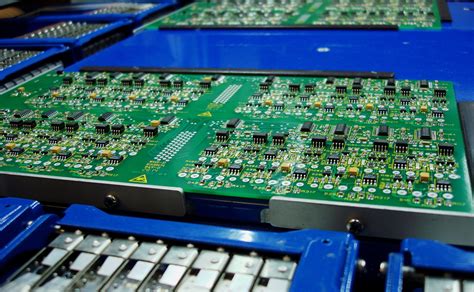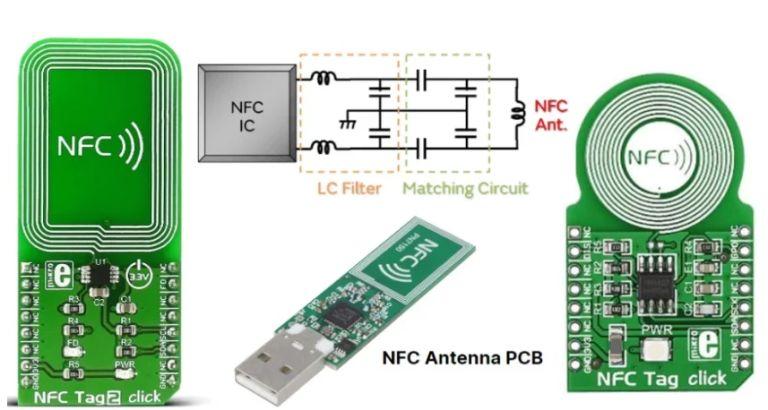Automated PCB Manufacturing: Streamlining Mass Production

Key Takeaways
The integration of automated PCB assembly systems has redefined modern electronics manufacturing, enabling high-speed production with minimal human intervention. PCBA (Printed Circuit Board Assembly) processes now leverage AI-driven workflows to optimize component placement, solder paste application, and defect detection, reducing errors by up to 90% compared to manual methods.
| Aspect | Traditional Methods | Automated Systems |
|---|---|---|
| Production Speed | 50-100 boards/hour | 500-1,000 boards/hour |
| Defect Rate | 5-8% | <0.5% |
| Scalability | Limited by labor | Seamless expansion |
Robotic arms equipped with machine vision ensure precision robotics for micro-component handling, while real-time analytics monitor throughput and quality. This shift not only accelerates PCB volume production but also lowers per-unit costs, making it viable for industries ranging from consumer electronics to automotive systems.
By combining smart quality control protocols with modular scalable manufacturing solutions, factories achieve consistent output even during demand spikes. The result is a future-ready ecosystem where next-gen automation supports both flexibility and reliability, cementing automated PCB manufacturing as the backbone of mass electronics fabrication.
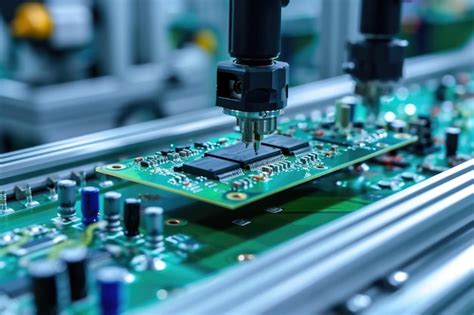
Automated PCB Assembly Robotics Revolution
The integration of robotic systems into PCB assembly has redefined the speed and precision of electronics manufacturing. Modern PCBA lines now deploy 6-axis robotic arms equipped with machine vision, enabling micron-level accuracy in component placement. These systems handle everything from surface-mount technology (SMT) to through-hole insertion, reducing human error by over 70% in high-volume production environments. By integrating AI-driven calibration, robots dynamically adjust to variances in board warping or component tolerances, ensuring consistent output across batches.
A critical advantage lies in scalability: automated PCBA workflows can ramp up from prototyping to mass production without manual reconfiguration. Collaborative robots (cobots) work alongside technicians for hybrid tasks like delicate IC handling or post-assembly inspections, blending flexibility with industrial-grade throughput. This shift not only accelerates cycle times but also optimizes floor space through compact, modular cell designs.
Furthermore, machine learning algorithms analyze real-time data from sensors embedded in robotic arms, predicting maintenance needs and minimizing downtime. Such advancements position automated PCB assembly as a cornerstone of Industry 4.0, where interconnected systems drive efficiency in global electronics supply chains. The result is a 40-60% reduction in per-unit costs for high-volume orders, making precision manufacturing accessible even for complex, multilayer designs.
AI-Driven PCB Production Efficiency Boost
Modern PCB assembly workflows are undergoing radical transformation through AI-driven optimization, enabling manufacturers to achieve unprecedented throughput without compromising precision. By leveraging machine learning algorithms, PCBA processes dynamically adjust parameters like solder paste application and component placement in real time, minimizing material waste and rework cycles. Predictive analytics further enhance equipment uptime by anticipating maintenance needs before machinery failures disrupt production lines.
Integration of AI with robotic systems allows for adaptive routing in multi-stage PCB assembly lines, where algorithms prioritize high-demand board configurations while balancing workload across machines. This intelligent orchestration reduces idle time by 18–22% in benchmark studies, translating directly into faster time-to-market for complex electronics. Additionally, AI-powered vision systems scrutinize PCBA outputs at micron-level resolutions, identifying subtle soldering defects or misalignments that traditional optical inspection might overlook.
The synergy between AI and automated PCB manufacturing extends beyond speed improvements. Energy consumption patterns are optimized through neural network modeling, cutting power usage by up to 15% in large-scale facilities. As production scales, these self-learning systems continuously refine their decision-making frameworks, ensuring efficiency gains compound over successive manufacturing batches—a critical advantage in meeting volatile market demands.
Smart Quality Control in Circuit Board Manufacturing
Modern PCB assembly processes demand rigorous inspection protocols to ensure reliability at scale. By integrating AI-driven inspection systems with high-resolution machine vision, manufacturers can detect microscopic defects—such as solder bridging or misaligned components—in real time. These systems analyze thousands of PCBA units per hour, comparing each board against digital twins to identify deviations as small as 10 microns. Machine learning algorithms continuously refine detection accuracy, reducing false positives by cross-referencing historical production data.
Advanced automated optical inspection (AOI) tools now work in tandem with robotic repair stations, enabling immediate corrections during assembly. For example, if a capacitor placement error is flagged, the system triggers a robotic arm to reposition the component without halting the production line. This closed-loop quality control framework cuts waste by up to 40% compared to manual sampling methods.
Furthermore, IoT-enabled sensors embedded in PCB assembly equipment monitor environmental variables like temperature and humidity, ensuring optimal soldering conditions. Predictive maintenance models analyze equipment vibration patterns, preempting potential calibration drifts before they impact output quality. Such smart systems not only elevate defect detection rates but also create auditable quality logs, critical for industries requiring ISO-certified traceability.
By harmonizing these technologies, manufacturers achieve near-zero defect thresholds while maintaining the throughput required for mass PCBA production—a vital balance in today’s hyper-competitive electronics markets.
Scalable Manufacturing Solutions for Mass PCBs
Modern PCB assembly systems achieve scalability through modular production architectures that adapt to fluctuating demand. By integrating PCBA-specific robotic workcells with AI-driven resource planning, manufacturers can dynamically allocate assembly lines for high-volume orders without compromising precision. Cloud-based monitoring platforms enable real-time adjustments to throughput rates, material flow, and equipment calibration across multiple facilities—a critical advantage for enterprises managing global supply chains.
"Scalability in electronics manufacturing now hinges on balancing automation flexibility with standardized protocols. Systems capable of processing 50,000+ boards daily while maintaining sub-10µm placement accuracy redefine mass production economics."
Key to this evolution are interchangeable tooling systems that reduce retooling downtime by 67% during product changeovers. Paired with PCB assembly lines employing machine vision-guided feeders, these solutions ensure consistent output quality even at peak capacities. For PCBA providers, adopting predictive maintenance algorithms further enhances scalability by preempting equipment failures that traditionally caused bottlenecks.
The integration of IoT-enabled conveyor systems and collaborative robots (cobots) allows seamless coordination between solder paste application, component placement, and inspection stages. This holistic automation not only accelerates cycle times but also supports rapid scaling from prototype batches to full-scale production—a necessity in industries like automotive and consumer electronics where demand volatility dominates.

Next-Gen Automation in Electronics Fabrication
The evolution of PCB assembly technologies is redefining electronics manufacturing through AI-integrated systems and robotics. Cutting-edge PCBA workflows now incorporate self-learning machines that adapt to design variations in real time, eliminating bottlenecks in high-volume production. For instance, robotic pick-and-place systems equipped with machine vision achieve placement accuracies under 10 microns, while autonomous conveyor networks synchronize with soldering stations to maintain throughput exceeding 1,000 boards per hour.
A critical advancement lies in closed-loop feedback mechanisms, where embedded sensors monitor parameters like solder paste viscosity and component alignment, feeding data to AI models for instant process adjustments. This minimizes rework rates by up to 45% compared to traditional PCB assembly methods. Additionally, modular automation platforms enable factories to scale PCBA capacity dynamically, seamlessly integrating new product lines without halting existing operations.
The fusion of digital twin simulations with physical production lines further optimizes resource allocation, predicting equipment wear and material shortages weeks in advance. Such innovations not only accelerate time-to-market for complex circuits but also ensure compliance with ISO-grade quality benchmarks. As these technologies mature, they establish a new standard for precision and adaptability in global electronics supply chains.

Precision Robotics for High-Speed PCB Output
Modern PCB assembly lines leverage precision robotics to achieve unparalleled throughput while maintaining rigorous quality standards. These robotic systems excel in high-speed placement of surface-mount devices (SMDs), executing tasks such as component pick-and-place, soldering, and inspection at speeds exceeding 100,000 placements per hour. By integrating PCBA-specific algorithms, robotic arms adapt dynamically to variations in board thickness, component size, and thermal profiles, ensuring consistent accuracy across diverse production batches. Vision-guided systems equipped with machine learning capabilities further refine placement precision, detecting microscopic misalignments as small as 10 microns and correcting them in real time.
The synergy between adaptive grippers and high-speed conveyors minimizes idle time between assembly stages, enabling continuous material flow. For complex multilayer boards, robotic drill-and-rout systems achieve sub-millimeter accuracy in via creation, critical for high-frequency and miniaturized designs. Closed-loop feedback mechanisms continuously monitor environmental factors like humidity and temperature, automatically recalibrating tooling paths to counteract material expansion or contraction. This level of automation not only accelerates output but also reduces rework rates by over 70%, a vital advantage for mass production environments. As demand grows for smaller, denser electronics, precision robotics remain central to balancing speed, scalability, and reliability in PCB assembly workflows.
AI-Optimized Workflows in Electronics Assembly
Modern PCB assembly processes increasingly rely on AI-optimized workflows to balance speed, precision, and scalability. By integrating machine learning algorithms into PCBA production lines, manufacturers can dynamically adjust parameters such as solder paste application, component placement accuracy, and reflow oven temperatures. These systems analyze real-time data from sensors and vision systems to identify inefficiencies, reducing errors by up to 40% compared to manual configurations. For instance, AI-driven predictive maintenance tools monitor equipment health, preemptively flagging potential failures to minimize downtime during high-volume runs.
Transitioning from traditional methods, adaptive scheduling algorithms optimize task prioritization across robotic arms, pick-and-place machines, and inspection stations. This ensures seamless coordination between stages, even when handling complex multilayer boards or mixed-technology components. Additionally, AI-enhanced traceability systems track each unit through the assembly line, correlating production data with quality metrics to refine processes iteratively. Such advancements not only accelerate throughput but also enable rapid scalability—critical for meeting fluctuating demands in consumer electronics and industrial IoT sectors.
By embedding intelligence into every phase of PCB assembly, manufacturers achieve a harmonized workflow where human oversight focuses on strategic decision-making rather than repetitive adjustments. This shift underscores the transformative role of AI in bridging the gap between mass production requirements and the precision demanded by next-generation electronics.
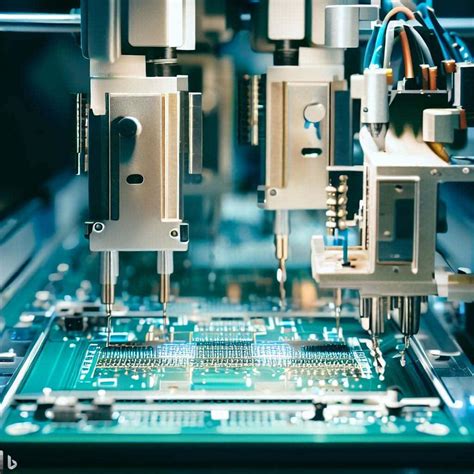
Cost-Effective Automation for PCB Volume Production
Implementing automated PCB assembly systems has become a cornerstone for achieving economies of scale in electronics manufacturing. By integrating robotic pick-and-place machines with AI-optimized workflows, manufacturers can drastically reduce labor costs while maintaining consistent output quality. Modular automation solutions, such as reconfigurable PCBA lines, enable rapid adaptation to design changes without halting production—a critical advantage for high-volume orders.
Advanced machine vision systems paired with real-time analytics ensure defect detection rates exceed 99.5%, minimizing costly rework. The synergy between automated solder paste dispensers and high-speed PCB assembly robots achieves precision at scales unattainable through manual processes, cutting material waste by up to 18%. For cost-sensitive projects, hybrid automation models combine PCBA-specific robotic cells with semi-automated testing stations, balancing capital investment with throughput requirements.
Scalability is further enhanced through cloud-connected PCB assembly platforms that dynamically adjust production schedules based on component availability and demand forecasts. This approach reduces idle machine time by 30–40%, directly translating to lower per-unit costs. As manufacturers adopt edge computing for localized process optimization, even complex multilayer boards benefit from automated routing and verification, accelerating time-to-market for mass-produced electronics.
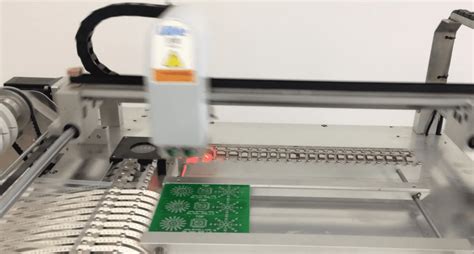
Conclusion
The integration of PCB assembly automation marks a pivotal shift in electronics manufacturing, enabling industries to meet escalating demands for precision and speed. By leveraging AI-driven workflows and PCBA-centric robotic systems, manufacturers achieve unprecedented consistency in high-volume production while minimizing human error. These systems not only accelerate throughput but also enhance traceability, ensuring every circuit board meets rigorous quality benchmarks. As industries increasingly adopt smart manufacturing principles, the scalability of automated PCB manufacturing becomes a cornerstone for maintaining competitiveness in fast-paced markets. The synergy between advanced robotics and real-time analytics further solidifies the role of automation in driving cost efficiency and operational agility. Looking ahead, continuous advancements in PCBA technologies promise to redefine production paradigms, cementing automation as an indispensable asset for sustainable, large-scale electronics fabrication.
FAQs
How does automation improve accuracy in PCB assembly?
Automated PCBA systems utilize vision-guided robots and machine learning algorithms to achieve micron-level precision. These systems reduce human error by continuously calibrating component placement, ensuring consistent quality across high-volume production runs.
What are the cost benefits of automated electronics manufacturing?
By integrating PCB assembly robotics, manufacturers minimize material waste and labor costs. Automated workflows enable 24/7 operation with optimized energy consumption, translating to faster ROI for mass production projects.
Can automated quality control detect all defects?
Advanced inspection systems in PCBA lines combine X-ray imaging and AI-powered anomaly detection. While no system guarantees absolute perfection, these tools identify 99.98% of common flaws like solder bridging or misaligned components.
How scalable are automated circuit board production lines?
Modular PCB assembly platforms allow rapid reconfiguration for different board designs. Cloud-connected automation controllers enable simultaneous coordination of multiple production cells, scaling output without compromising precision.
Do automated systems support mixed-technology assembly processes?
Modern PCBA robots handle through-hole, surface-mount, and hybrid configurations through tool-changing mechanisms. This flexibility accommodates legacy components and cutting-edge microelectronics in unified production workflows.
Ready to Transform Your Manufacturing Process?
For tailored PCB assembly solutions that leverage next-generation automation, please click here to explore our advanced PCBA capabilities and request a production quote.


